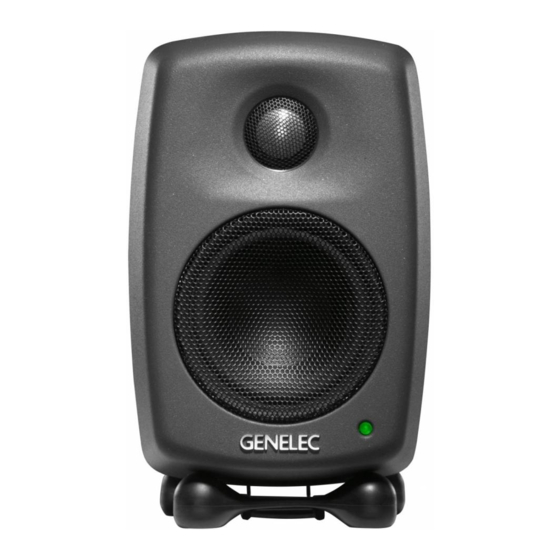
Genelec 6010A Setup Manual
Hide thumbs
Also See for 6010A:
- Quick setup manual (36 pages) ,
- Operating manual (8 pages) ,
- Datasheet (2 pages)
Table of Contents
Advertisement
Advertisement
Table of Contents

Subscribe to Our Youtube Channel
Summary of Contents for Genelec 6010A
- Page 1 The right monitors. The correct setup. Perfect sound. Monitor setup guide...
-
Page 2: Table Of Contents
Table of contents Genelec key technologies Active electronic crossover operating at low signal Genelec key technologies ..... 3 levels. What is a monitor? ......4 Monitoring ..........5 Optimized amplifiers. Each transducer is driven by its own optimized amplifier. Basics of system setup ...... 6 Monitor placement ........ -
Page 3: What Is A Monitor
Only then we can call it a reference monitor. Select the right Genelec monitor to serve as a perfect tool for your situation at www.genelec.com/learning-center/speaker-selection What is a monitor? -
Page 4: Basics Of System Setup
Monitor placement Identify your listening Step 1 area. Try to have 60° the listening position within the front 1/3 of the room. Place the monitors in 60° angle and point them towards the listening position. Step 1 Step 1 Avoid listening position Step 2 Basics of system setup. - Page 5 Cancellation 1.4 m. frequency and wall behind the speaker Monitor heights (ITU-R BS.775-1 standard) ‹15° ‹15° ‹15° 1.2-1.4 m You can easily fi nd the cancellation frequencies with the Genelec AcoustiTape. Ordercode MAI-0079. Basics of system setup. Monitor setup guide...
-
Page 6: Monitor Settings
If you have a large horizontal surface in front of the Step 3 monitors, a boost around 160 Hz boost typically occurs. Some Genelec monitors have a desktop control DIP switch, which compensates the 160 Hz boost by -4 dB. -
Page 7: Subwoofer Placement
Step 3 the procedure described in the operating manual. wall boosts the bass. Use sensitivity control to compensate the bass boost. A Genelec subwoofer reproduces the frequencies up subwoofer main speakers to 85 Hz and the monitors reproduce the frequencies above 85 Hz. -
Page 8: Room Improvements
Room treatments Calibration doesn’t necessarily give best results if the room is not acoustically properly treated. Some improvements can be made quite easily. There is plenty of information in the Internet and many acoustic professionals to help you out with room issues. - Page 9 Two opposite, parallel surfaces in a room sustain Refl ections can also occur between three or more the sound energy bouncing back and forth causing surfaces. Optimal acoustic situation is when you fl utter echo, standing waves or cancellation dips. receive a natural direct sound from the speakers to your listening position (a.k.a.
-
Page 10: Acoustic Improvements
Acoustic improvements Improve the acoustics in your room by following these steps: Step 1 Cut the corners, use MDF or drywall and fi ll the Step 1 empty space with mineral wool. Step 2 Use damping material on the front wall surfaces. Step 2 Step 3 Use damping material on the side walls. -
Page 11: Fundamentals
Sound travels approximately 340 m/s. It takes 3 ms to travel 1 meter. Ideally the sound volume drops by Sound volume increases 3 dB 6 dB when the distance doubles. when the power doubles. 100 dB 0 dB 100 W 85 dB 0 dB 94 dB... - Page 12 (or wall and desk) up to +12 dB and a two- wall corner with fl oor, desk (or even ceiling) boosts +18 dB +12 dB up to +18 dB. Genelec speakers come with DIP switches which are designed to compensate this frequency frequency boundary load effect.
-
Page 13: Monitor Listening Distance Recommendations
Monitor listening distance recommendations Low frequency boost correction in meter 6010A/8020B 8030A/8130A 8040A/8240A 8050A/8250A 1032A frequency 8260A 1037C The ideal situation is to have the room, the speaker and 1038CF/1238CF the listener in a good harmony. 1038B/1038BC 1034B/1034BC Each room is different and behaves differently when 1039A the speaker is placed in the room. - Page 14 SPL short term RMS Monitors -3 dB LF volume for 2-channel for 5-channel @ 1 m *) extension up to (Stereo) (Surround) 6010A 73 Hz 93 dB 55 m 5040A 5040A 8020B 66 Hz 95 dB 65 m 7050B 7050B...
- Page 15 Notes Notes...
- Page 16 Notes s o u n d p a s s i o n...
- Page 17 Olvitie 5 · 74100 Iisalmi · Finland T +358 17 83 881 F +358 17 81 2267 e-mail: genelec@genelec.com Genelec Document BBAGE084. Copyright Genelec Oy 2011. All data subject to change without prior notice. www.genelec.com 2 0 1 1 - 1...










Need help?
Do you have a question about the 6010A and is the answer not in the manual?
Questions and answers